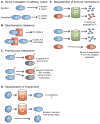The aneuploidy paradox: costs and benefits of an incorrect karyotype
- PMID: 21872963
- PMCID: PMC3197822
- DOI: 10.1016/j.tig.2011.07.003
The aneuploidy paradox: costs and benefits of an incorrect karyotype
Abstract
Aneuploidy has a paradoxical effect on cell proliferation. In all normal cells analyzed to date, aneuploidy has been found to decrease the rate of cell proliferation. Yet, aneuploidy is also a hallmark of cancer, a disease of enhanced proliferative capacity, and aneuploid cells are frequently recovered following the experimental evolution of microorganisms. Thus, in certain contexts, aneuploidy might also have growth-advantageous properties. New models of aneuploidy and chromosomal instability have shed light on the diverse effects that karyotypic imbalances have on cellular phenotypes, and suggest novel ways of understanding the role of aneuploidy in development and disease.
Copyright © 2011 Elsevier Ltd. All rights reserved.
Figures


References
-
- Hardy PA, Zacharias H. Reappraisal of the Hansemann-Boveri hypothesis on the origin of tumors. Cell Biology International. 2005;29:983–992. - PubMed
-
- Musacchio A, Salmon ED. The spindle-assembly checkpoint in space and time. Nat Rev Mol Cell Biol. 2007;8:379–393. - PubMed
-
- Storchova Z, Kuffer C. The consequences of tetraploidy and aneuploidy. J Cell Sci. 2008;121:3859–3866. - PubMed
Publication types
MeSH terms
Grants and funding
LinkOut - more resources
Full Text Sources
Other Literature Sources

